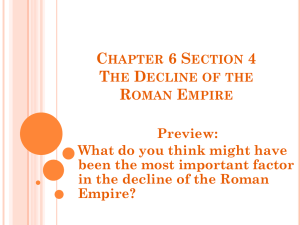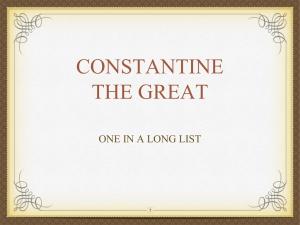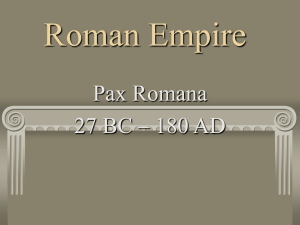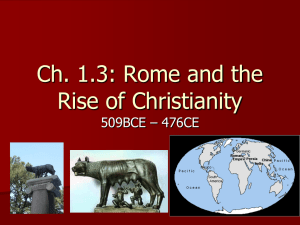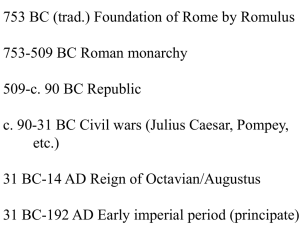The Roman Empire
advertisement
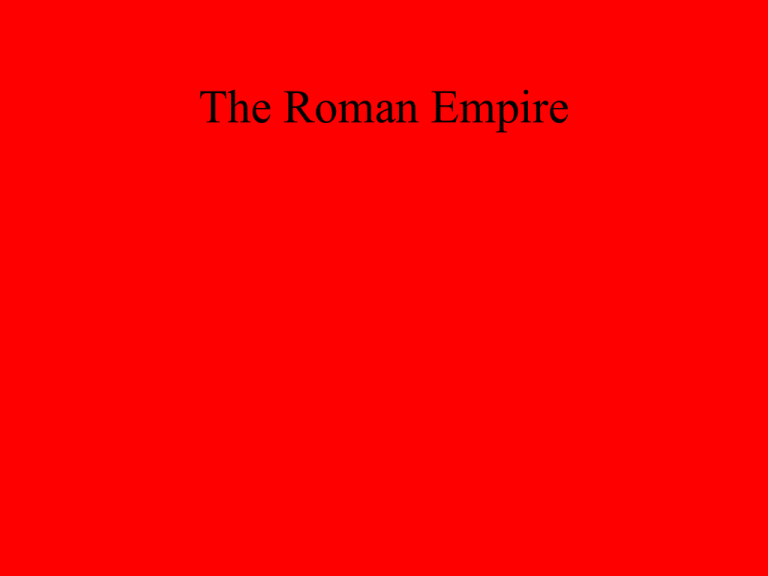
The Roman Empire Classical Roman Empire • Rome was one of four Classical Empires: – – – – Han China Mauryan India Parthian Persia Rome • All arose between 200-100 B.C. • Characterized by their unification around at least two widely disparate geographical regions. The Classical Empire • All four classical empires had been united by force and would not have stayed together had not the rulers formed institutions to do so. • Rome was created not by the ability to conquer lands but it’s need to develop the institutions necessary to consolidate and rule those lands. The Classical Empire • Each Empire used basically the same unifying institutions to bind the Empire together: – – – – – – – Common Language Currency System of weights and measures Networks of roads and canals Standing army Centralized authority Professional civil servants Comparison of Eastern and Western Europe • Western-Western Mediterranean • Eastern-Influenced by Greek culture Eastern Western Population Dense Sparse Society Urban Tribal Education Literate Oral Law Written Customary Economy Commercial Agricultural Exchange Money Barter Living standard Wealthy Poor Language Koine Mixed Geography • Most of Roman population lived within reach of Mediterranean – Romans worked to keep sea clear of pirates for they realized the Mediterranean was dependant on it’s unity. – Romans called it Mare nostrum or “Our Sea” • Outlying reaches of the Empire were connected by rivers and streams that flowed into it. – Romans actively were dredging ship channels and building in river ports – Channels and water systems used for thousands of years even after fall of the Roman Empire Geography • Complex water routes were knit together by system of roads and bridges that are even used today. – These were built not by technology alone, but by extensive organization. • Romans were aware that the expensive army would not be in combat more than 10% of the time, so the government came up with ways to use their force effectively. – The roads were used by the military and was even able to reduce the armies size without reducing it’s effectiveness. • The great network of land routes that helped to unify the empire was a byproduct of this “policy of cost containment” Government • Absolute Rule of an Emperor who was considered to be a god. • Execution of Emperor's will was by a trained bureaucracy. – Though it was small in comparison with modern states and was rudimentary with the Han empire of China, it was superior to anything that had preceded in the West. Government • To citizens the emperor was a distant figure only on coins. • Romans lived their lives in their local civitas, local unit of government similar to an American county. • Civitas consisted of two parts: – City-in which political, commercial and cultural life was concentrated. – Pagus- countryside dependant on that urban center. Government • Most civitates attempted to emulate the capital Rome. – Though they did not have an impressive law court of basilicas or amphitheaters they did boast public baths, busy markets, and anything else the rich pagus could spend in the city to endow it. • Local life throughout the empire was centered on these communities and it was the same wherever the Romans went, from Scotland to the Syria. • Each civitates had the three basic similarities: – Well-developed written laws – Uniform currency – Uniform system of weights and measures Military • The large standing army was concentrated on the frontier and defended the interior of the empire against foreign invasion. • Most recruits came from poor and isolated regions of Italy they were taught from the bottom up by the military. – They were taught Latin, to practice personal hygiene, and learned one or more trades (developed MOS). • The Army controlled and ran brick factories, tile manufactories, and many other enterprises that demanded physical labor. • Enlisting was a career commitment since it was a 25 year standard enlistment. – Each year was marked off by the celebration and great rituals honoring Roma, the goddess who exemplified Rome. Military • Even when Rome fell into disorder or when the imperial administration fell to corruption it was the army’s reverence for the ideal of Rome that remained undiminished, even if it meant storming Rome trying to acclaim their general of new Emperor. • Most spent their time in towns building little villages into what they exemplified Rome to be. • Stationed on the frontier, they created transportation and communication networks. – Roads, bridges, beacons, canals, ports and aqueducts. Military • The Roman frontiers in the West were not meant to keep people out but to control their passage. • A great deal of trade moved through the frontier zones. – Germanic people settled just outside of the frontier in places where they could enjoy extensive and secure relations with the Romans without their control. – These towns were more Roman than Rome so some Germanic tribes grew comfortable with their presence and even emulated their culture in some areas. • In many cases where the Romans could have certainly fought and won the area over, most just proved simpler to win them over and enlist them as allies of the Roman state. Military • Wherever it was sent or wherever it was settled, the Roman army provided local inhabitants with an outstanding example of Romanitas, the sense of belonging to a great civilization. Culture • The Romans established Latin as the common and official language of the empire, but also adopted Greek culture and, in a form called Graeco-Roman, spread a common literature, architecture, art, etc., throughout the empire. Economy • An economic balance was maintained between the wealthy and productive East and the relatively poor and backward West. • The East was taxed heavily, and the money transferred to the West, which was used to purchase goods from the East. Religion • Established a strict policy of religious toleration • Freely adopted and adapted gods and goddesses of the people they conquered, and process called syncretism (essentially an inculcation of the Greeks and other worldly deities). • Promoted a certain degree of commonality by establishing and promoting emperor worship. – Saluting the flag, formulatic pledge of allegiance, standing when singing the national anthem, reverence for the cloth of the flag. Intangibles • Pax Romana: Roman Peace- The Romans brought and unprecedented degree of peace and security to their empire. • Romanitas: The sense of being Roman- a deeply held sentiment and outlived that empire itself. – Such institutions required attention and constant effort to maintain – A weakness in the Roman imperial system let to internal wars and civil strife that eventually made it impossible for the government to continue as it once had. Intangibles • The Annals of Tacitus provide an insight to the management of Roman affairs and were written by a man who had a role in that management. Intangibles • The Romans were unwilling to give up their reverence for republican government even when it was no longer effective due to Caesars, Despots, and absolute corruption • Augustus Caesar converted the Republic to an empire in about 14BC—what he did was make all the political and domestic administrative offices answerable to him and his decisions—a streamline effect. To preserve the republic!!! Intangibles • The issue that always plagues these types regimes—we see it in Islam, Socialism etc …inadequate and unstable system of imperial succession—Created a perpetual struggle for Power … The empire fell victim and was only a strong as its next Coup. • To understand Augustus it would be prudent to read his personal account of his greatness … • The Deeds of the Divine Augustus. Important Chronology • 69 AD—Civil War on frontier to replace Nero • 69—192 AD—era of military emperors— ineffective and inefficient administration—led to a bloody Civil War initiated by Septimius Severus (193—197). • 198—282 essentially 100yrs of peace, but peace ended by 258 and Rome fell into the era of the 30 Tyrants (258-283 AD) Chronology • 283 AD German Tribes raided at will on the western fringes of the Roman Empire • Diocletion came to power in 283 AD and began with sweeping reforms in the imperial system— land reform, lower taxes, and more representative government. • Essentially this was the end of what is termed the Glory that was Rome. History 101 Roman Empire • Diocletian's successor was Constantine. • Rome now a different place and this is the beginning of the character of what would become • Medieval Europe. • What followed was another Roman Empire, but one distinctly different under the reign of Constantine. Reforms of Diocletian (284-305 d. 311) • Political reform— Empire divided into two distinct regions. • Unfortunately he left the much larger and impoverished western region vulnerable. Reforms of Diocletian • Unfortunately the western lands were mostly tribal and underdeveloped academically, economically, and technologically. • Large frontiers (costly to protect) and a very small tax base to support development and military presence. • Diocletian established a base of succession—two emperors were to be chosen for respective regions—each appointed a Caesar (emperor in training). Reforms of Diocletian • Stable form of succession—failed. • Established smaller provinces with both civil and military governor— created gov’t interference and destroyed the influence of the middle class. • The Gov’t controlled the tax laws and taxed the middle classes and the urban areas to destruction Economic Reforms • Smaller created more concentrated government, but also created hundreds of small squabbles and eroded cohesion. • Diocletian ended Debasement (reduced quality and value of Gold by printing money—devaluing the dollar if you will). • Re-established the Gold standard—unfortunately, there was very little Gold in circulation—created an economic depression—very little Gold reduced consumer prices— money became more valuable than goods—so people hoarded money or traded in Gold rather than consumer goods. Economic Reforms • Reformed Taxation—reduced it to two categories: Property and head tax. – Property was a progressive wealth tax – Head tax was a flat tax—both were very extreme. • Unfortunately both taxes were extreme • Ended farming tax—where the government had the right to come in an action off a farm to collect taxes on the land. • Tax collectors bided for the right to collect taxes Economic Reforms • Taxes led to abuses. • Exempted Senatorial class from taxes (hereditary) • Farmers were sold into slavery (along with family) if no tax can be collected. Beginnings of Fiefdom. • Full weight of the tax code fell on businesses and the middle class. Economic Reforms • Diocletian thought that making tax collecting the responsibility of the Urban middle class, it would be frugal and possess integrity. • Unfortunately if the government expectations of the agreed upon tax assessment came up short, the Curiales (urban middle class) was required to make up the difference. Economic Reforms • The fallout of well intended policy: • Urban middle class fled the urban centers; however, this was ruled illegal, so many with their families were also enslaved and financially, socially, and emotionally ruined. • Established a permanent dependent class that the governmental structure was ill-equipped to administer with any efficiency. Financial center shifted to the villas of the western countryside—established a ruling planter and baronial class. Military reform • Abandoned frontier defense—open to invasion. • Security was abandoned in the name of economics. • Downgraded frontier legions, used mercenaries and militia—notoriously lacked loyalty and verve to the empire. Military reform • Frontier troops are Garrison status. • Training neglected—more into infrastructure labor. • Discipline and esprit d’corps diminished. • Barbarian mercenaries— changed to a mobile army stationed in interior. Military reform • Barbarian Military was problematic—tended to be loyal to the purse rather than the state. • Internal and transportation infrastructure usually the job of the military when not engaged in combat went by the way side—barbarians are warriors, not civil servants and laborers. • Huge loss of communication and transportation system—The empire decaying from within. Social Reform • Combated the urban flight by making their status hereditary. • Required to remain in trade of father or mother—no way to rise above one’s born station in life. • This ended social and family mobility. • This in essence killed what was left of the conceived greatness of the Roman Empire. To combat this loss of spirit and enmity toward the government—Diocletian blamed the Christians—extermination began with fervor. Reforms of Constantine (307-337) • Continued with Diocletian’s policies, but did make some very recognizable changes. • Recognized Christianity as a favored religion. – Christianity official religion 396 AD in both Western and Eastern provinces—Western became very catholic and eastern remained mostly Orthodox. • Made east very prosperous; increased gold currency (coinage) by seizing endowments of the Pagan Temples. Reforms of Constantine (307-337) • He also ended the idea that the tax code had to balance even with unequal taxation on the east to make up for the shortfalls of the West. • Shifted center of Empire from West (Rome) to East (Constantinople or Istanbul). • The best and brightest fled the west and went East. • By 400 Rome was no longer the Imperial capital. Rome (?) • 404 AD western version of capital moved to Ravenna in Northern Italy. • Protected by marsh and fortified harbor. • Rome sacked by Alaric and the Visigoths in 410. • Not much there, only the catholic Bishop (Pope). • 455 AD Attila attacked what was left of Rome. Western Rome • Loss of middle class and Tax base, became very much Medieval in character. • Planter and Baronial class became powerful and essentially a slaved or serfdom society. • Christian religion was state religion—all others forbidden. Constantine and Catholic Church • Church became center of Imperial Government. • Administered all social and economic services. • Early shared power with Government, but eventually became the main political power broker in western governments. Constantine’s Reforms and Decay of the West • Emperor semi-divine • Military power was mostly Germanic tribes. • Impoverished because of the decay of middle class. • Transportation and Marine endangered by Thugs and Pirates. Western Decay • West almost cut off completely—lost communication, lost sharing of ideas, and loss of connection as Romans. • Power in large landowners—eventually in the hands of the Church, as the Church gained large estates. Peasant under class. • Loss of frontier protection—open to invasion and loss of civil order—Pax Romana vanished. Conclusion of Rome • Regardless of tension and detriment to society, Rome collected taxes and forced an imperial government on the populace that neither benefited them nor protected them. • Western Rome—superfluous, poverty stricken, and ruined manufacturing industry—lost trade consumerism with the Germanic tribes (huge consumers). This trade enhanced their way of life and was a bargaining chip to help create a secure border of the western provinces. Christianity and Mediterranean • History 102 • Western Civilization I • The Rise of Christianity Christianity • Rose out of Judaism • Reform movement • Apostle Paul opened the religion to non-Jews and gave it its Greek Flavor • Roman religion no moral base or message of hope. • Christians Martyred not because they were Christians, but because they were REBELS!! Roman Religions • Myriad of religious systems and types of deities. • The Pantheon– gods and goddesses of mythology. • Old gods—Chronos, Uranus and others overthrown by the Olympians. • Titans—Friends of humanity—Prometheus (fire) • Demi-gods—Ganymede servant to the gods. • Heroes—human achieve godlike status— Hercules—important part—demarcation between god and human was miniscule. • Lot of local, regional and nature deities. Roman Religions • Many religions were derivatives of the Greek system and the philosophical systems such as (Epicureanism, skepticism and stoicism etc . . .). • Mystery Cults (Isis, Mithra, Orpheus etc …)These tended to offer hope on a moral basis based on human action and interaction. • Initiates and rituals—purifying bath, eating and drinking of blood and body of founder—many had something in common with Christianity. Christianity • Founder was an actual person • Jewish legal code and traditional morality. • Could adopt and adapt: Christmas taken from Mithras; Madonna taken form of Isis—other traditions borrowed Character of Christianity • Early Christians were Bigots; • Zealots; • Evangelicals; • Expand Christianity; • Appealed to the downtrodden; • Appealed to Women, • Low-skilled workers; Prostitutes, uneducated; slaves, tax collectors and fishermen Character of Christianity • All oppressed and despised peoples saw an ally in Christianity; • Christianity viewed all peoples without contempt, except the rejecters of the faith; • The message was HOPE and hope is all we have at times—more important than love!!! Credibility of Christian Converts • Usually only true believers since essentially one was signing their death warrant; • Sect’s numbers were periodically purged due to Roman persecution; Culled the vacillators easily—converts were very zealous; • Blood of martyrs was the real seed of the Church.” Credibility of Christian Converts • The Martyrs established the credibility and prestige of the early Church. • Met horrible deaths with equanimity and even joy; • Ostensibly something worth dying for—this was tantamount to a higher power and a stronger more powerful God; • Those of little faith were impressed and the Roman attitude and respect for strength and bravery was also impressed. Moreover, Christianity in fact, miraculously survived the persecutions. Development of Christianity, AD 63-313 • Developed as a reform movement within Judaism; • After the Jewish Rebellion 89-90, the Jews suffered the Great Diaspora or scattering. • This reform began in the Jewish urban centers; in fact some historians label it a Ghetto Religion. • It also spread into the countryside or Pagus(Pagan religions also embraced Christianity—moreover Christianity inculcated many of the Pagan traditions and symbolism. Development of Christianity, AD 63-313 • Early members were of the lowest class; • Many of today’s middleclass would have more than likely rejected Christianity because of the low class clientele. • Though many historians always use the hygiene analogy, it must be remembered that hygiene was/is very important to the Jews—many of the early Christians accepted Christ, but maintained the traditional Jewish law—ala Old Testament. Early Christians • Very intolerant of other religions; • Strictly monotheistic; • Followed the command to go forth and evangelize; • Followers must undergo a complete conversion—no eclecticism; • Rome respected and observed many religions; because the Christians did not they were labeled “dangerous rebels to the empire” and were persecuted harshly Early Christians • For security many of the Christians hid in the catacombs and other clandestine places to practice their faith; • They formed inner city groups (ecclesiae); had their own political and social leaders called (episkopos>piscop>biscop>bishop. • They wrote letters and and kept minutes of their meetings (epistles) and passed them to other Christians surreptitiously. Early Christians • Secret meetings were called Councils. • The minutes were kept in secret books (Bibles). • They developed secret signs and symbols for converts’ recognition. • Christianity grew slowly through the middle class and the army—but it eventually gained a following second to none and challenged by few. Official Recognition of Christianity • Story is muddled, but Constantine used the Cross (symbol) thereby gaining the support of many Christians and Warriors who were closet Christians—there were many more than the state had ever imagined—This was the famous battle of Milvian Bridge—Victory ensured that Christianity would be recognized, legitimized and no longer persecuted— • Christianity would now be tolerated as a favored religion. Emperor Constantine • Great Political Move—needed to harness the zeal of the Christians to gain control of Roman Empire; • Constantine helped legitimize and give secular political organization and control over Christianity; • It is no longer an underground movement—it is now an institution. • Jesus founded the Christian Faith—but Constantine founded the Christian Church. Political and Social Legitimacy • Still, there was early dissension in the Christian Church based on legitimacy and philosophy— many interpretations of who, what, and how was Christ. • Constantine did not wish the power base he had legitimized fall apart with muddled philosophy; • 325 AD called all Bishops together to form a unified consensus—set a standard all Christians could accept, a common prayer book, and ritualistic liturgies and religious services. Political and Social Legitimacy • The Council of Nicea came up with the Nicene Creed. • All (legitimate) Christian services were to incorporate this formulation; • He also very adeptly shifted the center of empire to Constantinople—it had no pagan traditions and easily embraced the Emperors new faith— Christianity. Secret books were formed into a Canon—representing a true Christian faith. Conclusion • Shortly after establishing a uniformed structure, Constantine died—some say he only accepted baptism on his death bed—there is no proof or credibility to this. • He did make an underground movement, a persecuted ghetto faith into the most recognizable religious faith in the world. • Christianity offered hope, peace, love, and forgiveness (only religion to have these as precepts) and more importantly it had triumphed over all its competitors—made it seem very special Indeed! Justinian AD 527-565 • Final end of the Roman Empire; • Established the Byzantium Empire; • Helped usher in Medieval Ages in Western Europe; • Made possible the spread of Islam; Rise of the Franks; • Theodora a remarkable woman. Justinian’s Wars • He fought a series of war’s against the Germanic tribes of the Visigoths, Ostrogoths and Vandals. • Why? To preserve Christianity and the eastern Kingdom. • Many of these western areas were mostly controlled by Germanic Vice-Roys or Arians, who practiced their own brand of Christianity. • Arian Christianity had issues with the true divinity of Christ—did not believe in the Holy trinity as one. Jesus was a man, but his human status did not diminish the credibility of Christianity. It did, however, conflict with the rising power and status of the Catholic Church. Vandals • Vandals most zealous of the Arians; • Seized catholic Churches and converted them to Arianism; • Vandals small in number—so resorted to very heinous and terrorist acts to maintain power base. • Essentially became what centuries later would become the model for the Gestapo— force, coercion, and brutality. Vandals • Vandals striped the Christians of their property, civil rights, economy, and life and limb. • Again, very reminiscent of earlier Christian persecutions. • Justinian thought it best to bring West back under the control and auspices of Roman Empire. • West did not want back under the Roman umbrella—just make Vandals and others stop the persecution. • Many in the West, feared Justinian more than the barbarians—so they joined the barbarians against Justinian’s legions. Justinian’s Legacy • Regardless of Military costs, Justinian had enough money to embark on a huge building program; • Church of the Holy Wisdom (Hagia Sophia) dominates the skyline of Istanbul; • Collecting and codifying Roman Law; establish a component of legal jurists (Lawyers and Municipal legal codes) and putting the law into writing. Justinian’s Legacy • The east was prominently Greek influence and administrations were better in a Greek format; • He eliminated the use of Latin languages and embraced the Slavic Greek orthodoxy; • Other classical empires fought back the Barbarians, only Western Europe remained under the grips of barbarism— good and bad—Western Europe now experiencing an independent development. Justinian’s Legacy • Justinian’s tribute to Persia became a failed policy, by enriching the Persians and weakening Constantinople • East became more and more aggressive collecting taxes to pay the tribute and to fund the enormous building plan; • Justinian dies in 565 and the Persians invaded and destroyed much of the east—Herclius slipped out by sea and invaded the unprotected Persian cities creating a stalemate and weakening both economies— • This left both nations weak and easy pickings for the Huns stampeding off the Savannas led By Attila. • Many welcomed the Huns and converted to Islam blocking the east off from Christianity for several centuries. A New Western Perception • Justinian’s wars also left the Barbarians weak and fragmented; • Only power left in the West was the Burgundians; • Least able group to maintain or embrace Romanization; • Did have a Frankish alliance with the Catholic Church; • Changed perception and future of Western Europe. Conclusion of Roman Empire • Great men have Great Control of events—that is the prevailing wisdom—not always true. • Changed the development of Western Europe; Unfortunately ushered in the Middle Ages (Dark Ages); • Justinian’s failures were more prevalent than his achievements—cut all communication and dialogue between East and West—still an issue today. Conclusion of Roman Empire • Elimination of the Latin language ensured a perpetual split between east/west; • Failed to unite the western leaders who may have preserved semblances of the Roman empire; • Strengthened the Persian Empire and helped initiate the dominance of Islam in the East; • Destruction of the Germanic tribes allowed for the rise and dominance of the Medieval Church. Rise of the Franks • Franks were left standing in power after Justinian’s attempt at reconquest. • Inhabited the the Rhine and Scheldt river areas; • Occupied mostly of what is now Netherlands and Northern Belgium; • Very active agriculture and commerce and trade centers; • Franks were mostly hunters, trappers, and warriors and were a great supply for mercenary troops for the weakened Roman Legions. Franks • Not very sophisticated or socially or politically organized; • Mostly tribal and vicious; Pagan worshipping ie. Thor, god of thunder and Wotan, the sky god; Tew, the warrior god; • Strongly male and dominated not necessarily by the wisest of council, but the bravest and strongest—Chiefs acted as rulers and priests—power from single family lineage, descended from Wotan. Franks • Expanded inland from the low country and the sea; • The sea group called the Salic Franks (sal-salt or sea); • Became the ancient ancestors of the French and the basis for Salic Law or French Law and customs (important later on). Franks • As they moved inland they became stronger and a much larger clan—with time they became very strong and warlike— • In 430 AD they occupied land between Soissons and Cambrai—Soissons a large armory for the Roman Legions fell into the hands of the Franks. • They now could equip a much larger army with modern weaponry; they joined with Aetius and the Legions that defeated the Huns—felt somewhat a part of the Empire. Franks • Join the Court of Aetius; • Aetius murdered by conspirators at Ravenna 453 AD; • Franks liked Aetius and renounced anything empire and any allegiance or alliance in 453. • AD 476 Odovacar, Germanic Leader of the Roman army in Italy, deposed the western emperor; Franks began an independent life forsaking and despising anything Roman. Clovis • 15 year old Frank—Clovis is a form of “Louis.” Name of the French Royal dynasty. • Single extended family important so Clovis kills off family members to reduce the competition; • Consolidated other tribes under the aegis of his strong rule by killing off other competitors. • 486 AD began his own wars of conquest and consolidation—importance is Clovis made what is now Paris his home base. Clovis and Christianity • Constantine moment—he needed to defeat the Burgundians, but they had consolidated with other Arian Germanic tribes— • Battle in doubt—took an Oath to embrace the catholic Church forsaking the Arian doctrine—if God would allow him victory—or to get the Christian community to join him in battle? Clovis and Christianity • The stage is now set for the advance and dominance of the Catholic Church – and set the stage for Church/State issues and will begin the line of the Holy Roman Emperors through the Merovingian dynasty. • Defeated the Visigoths and seized control of all France and much of the German territory to the Rhine. Merovingian Dynasty • All in all, ruled for about 300 years; • Political structure was monarchical—all lands, towns and villages were considered personal property of the King; • Royal family moved from estate to estate for subsistence; everything was supplied the royal family from these estates and villages; • Household servantry became important—such as Mayor of the Palace or head servant(Butler) oversaw all economy, politics, social functions, human resources, etc . . . Beginning of the Palace bureaucracy (head ministers etc . . .). Merovingian Dynasty • Ministers—means to serve—servant; • These servants posts became functions with Royal French Titles; • Wherever the King was not, he left in control Strongmen (women) who would later become Earls, Counts and Dukes—of course appointed by the King. Merovingian Dynasty • Law based on custom; kinship and feuds; • No concept of state responsibility; • Power was passed to heirs; • Gavelkind—division of property equally among the children (legitimate and illegitimate). • Royal and lands and titles were passed along hereditarily. Hereditary Issues • Kingship tied to heredity and power; • Lands divided equally—so it created intrigue between heirs seeking the ultimate prizeKINGSHIP; • It also created palace intrigue to gain the highest Ministerial slots—see why there was so much turn-over and unexplained deaths; • Created constant Civil Wars—though powerful, in the long run created weaknesses to be exploited by the powerful or even the hated enemies of the dynasty—still it worked for over 300 years. Power Base of the Franks • Expanded rather than migrated; numbers constantly increasing; • Expanded slowly and always appeared as nonthreatening, as did the over zealous Vandals and Visigoths; • They incorporated much Roman citizenry— appearing as allies rather than threat; • Geography protected them from the invading Huns and Muslims; • Neither the Muslims nor the Byzantine court desired to bring the Franks into their fold—they looked fragmented and innocuous at best. Power Base of the Franks • Traditional opponents and enemies were always distracted or weak from their own wars; The Visigoths and Burgundians though Barbaric and brutal never had the true love and support of the peasantry—they easily allied with the Franks and their brand of Catholic Christianity; • The peasantry despised the Arian barbarians; • Franks worked with a primitive style government. Power Base of the Franks • Forsook all things Roman especially the taxation program, which aided in creating alliances with the peasantry; • Visigoths and Ostrogoths, and Vandals tried to maintain the Roman tax system; • Franks allowed for local governance (akin to states rights); it seems here was the perfect time for decentralization of government; • Local governments (villages, towns, or cities)if responsible were allowed complete autonomy. Power Base of the Franks • Because of their primitive governmental structure, they allowed for local talented and effective rulers to rise into the Frankish “aristocracy” • Frank rulers did not embrace vague notions of imperial power; they accepted their local kingdom rule and living off the tribute of others; • Because of such local autonomy, governmental structure was not repressive nor intrusive. Power Base of the Franks • Because of Clovis they enjoyed the support of the Church; • Possessed religious continuity throughout the kingdom; • Peasants did not care whether the rulers were good Christian; • Church provided them with skilled literate administrative personnel; • Moreover, when the Franks did expand they had the benefit of missionaries and clergy to educate and help pacify the populace; stroke of genius. Conclusion • BY the 600s, All things Roman, for the most part, had disappeared; this loss of alliance and security for the Church could have been debilitating; • However, the Church found a new alliance with the Franks; • Franks had many alliances, but the Church was the most important. Rise of Western Church • Christianity not truly legitimized until AD 313 after the death of Diocletian; • West different from the east—more centralized and unified institutions; • Christianity helped further separate the West from the east—interesting considering the early Church embraced the imperial nature of Constantine’s government; • Churches would operate on local levels—gaining an unintended Grass Roots dominance that would benefit it later; Rise of Western Church • These local Civitates formed the central governmental and municipal basis for Western forms of government; • Administrative positions were filled with Clergy—they were literate—educated and many learned in Law; • Began the practice of Investiture—Church Administrators confirmed the appointment of governmental officials through ceremony—to be clothed in the office; usually conducted by two or more Bishops to add Church and Social and Political credibility to the office—the President is sworn in with the Bible. Rise of Western Church • Church focused on Urban centers; later the agrarian western lands; • Local power allowed to elect their own Bishops and Church Leaders; • Unfortunately this would lead to the secularization of the Church– and few men with any true meaning of the Christian faith—powerful church not all good. Western Church • Division and sectarian factionalism became troublesome for the Church; • Nicean Council was to resolve this—it did not; • Split between Athanasius and Arius—difference between the Holy Trinity one and the same—triumvirate equality—Arianism human divinity of Christ. • Big solution, which worked in the West fairly well was to centralize the strength and power of the Church. Establishment of Bishops and Pope • To create continuity—established the Bishop’s of Jerusalem, Antioch, Alexandria, and Rome; • Uniformed faith came up short, but it did define a uniformed definition and character of the Christian Church; • This led to the uniformity of liturgy, practice, and iconography; The Canonization of the books of the Bible; Prayer Book, and adoption of the ten Commandments—translate (Greek and Hebrew) into Latin (common language). Western Church • The Western Church was able to establish the progression of the Pope based on the lineage of Peter—who died in Rome; • The Petrine Doctrine, or Papal Primacy -• “on this rock shall I build my church …” This became the basis and earthly divinity of the Pope. Pope Leo I The Great negotiated the security of Rome with the Huns— seemed divine intervention— Pope is now the Church!! 3 Famous Early Christian Scholars • Latin Fathers: • Jerome who translated the Greek and Hebrew into Latin; • Ambrose defined functions and roles of the Church Hierarchy—established Bishops higher then Emperors because of the divine nature of their position; • Augustine who explained Christian Doctrine and explained the tough questions in formal and informal language, ie, evil, predestination, God’s influence in small matters Arian Persecution of the Catholic Christians • Though unintended, the early Catholic Christians, were being persecuted by the Arian Christians; • Catholics out of necessity had to bind together for security • Supposedly direct lineage to Peter also helped their cause. Conclusion • To avert the East from capturing power in the West, Lombard Tribes (Italians) secured peace and continuity in Rome; • Rome sole champions of Roman culture, which they transformed into the iconography of “True Christianity.” • Pope Gregory I, (Papal Primacy) a masterful administrator, put the Church on a sound financial standing and established legal and social acceptance of the Episcopacy—also made missionary and evangelizing a major work of the church; • Converted the Pagans, celts etc … Modern Church Identity • • • • Pope—Vicar of God—earthly emissary; Strong centralized administrative structure; Less interested in theological disputes; More interested in establishing a refined and uniformed, rational and coherent set of rules and regulations controlling political and liturgical doctrine of Church; • Established Missionary Activism; • Bound to Spread the “Good News.”


